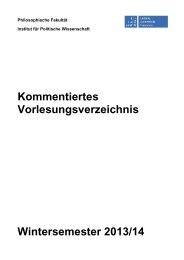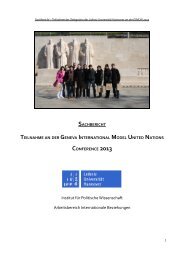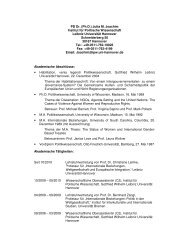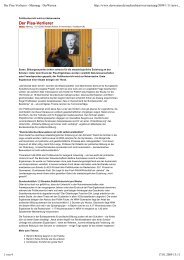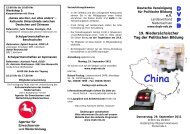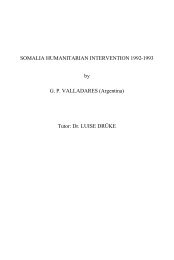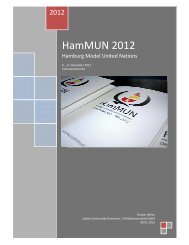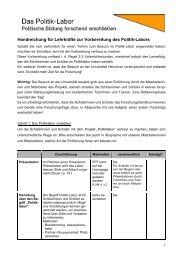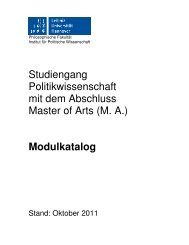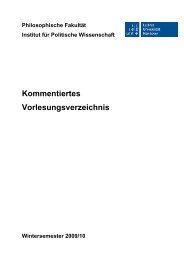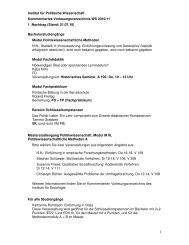Preventive Action for Refugee Producing Situations
Preventive Action for Refugee Producing Situations
Preventive Action for Refugee Producing Situations
Create successful ePaper yourself
Turn your PDF publications into a flip-book with our unique Google optimized e-Paper software.
132 Chapter 3<br />
eign Relations. On 20 February 1968, Secretary of Defense Robert<br />
McNamara testified be<strong>for</strong>e the Committee that when the facts had been<br />
established to the complete satisfaction of all responsible authorities, the<br />
U.S. had responded with an air strike on the facilities that supported the<br />
attacking vessels in the Gulf of Tonkin. Mr. McNamara's testimony<br />
prompted the chairman of the Committee to raise the matter of the contingency<br />
draft of the Southeast Asia Resolution "Mr. McGeorge Bundy<br />
[President Johnson's National Security Advisor] told this Committee that<br />
this draft had been prepared some months be<strong>for</strong>e the Tonkin incidents in the<br />
hearing. " 306<br />
Harry Summers Jr., an expert on military affairs, bluntly described the<br />
duplicitous resolution and its consequences:<br />
In voting unlimited presidential power, most members of Congress thought they<br />
were providing <strong>for</strong> retaliation <strong>for</strong> an attack on our <strong>for</strong>ces, and preventing a largescale<br />
war in Asia, rather than authorizing its inception... . 307<br />
Once the Americans got involved, they found that their adversaries were<br />
conducting warfare mainly with guerrilla tactics, <strong>for</strong> which the American<br />
and their South Vietnamese allies were insufficiently prepared. Finding<br />
themselves outmaneuvered, they resorted to a strategy of large-scale<br />
bombardment.<br />
The level of warfare produced correspondingly large flows of refugees. 308<br />
Reports pointed out that people were <strong>for</strong>ced to flee to escape from both<br />
Communist harassment and American bombings. 309<br />
Whatever its strategic value, the bombing was overwhelmingly<br />
destructive. By the end of the war, the U.S. had dropped 7 million tons of<br />
bombs and dumped another 7 million tons of explosives on Vietnam,<br />
compared to 2 1/2 million tons in Europe and the Pacific during World War<br />
II. Vietnam thus earned the unwelcome distinction of being the most<br />
heavily bombed country in the history of the world. The result of that le vel<br />
of violence was that one person in every thirty was killed, one in<br />
_______________________<br />
306 U.S. Senate. The Gulf of Tonkin: The 1964 Incidents; Hearing be<strong>for</strong>e the<br />
Committee on Foreign Relations, 1968, p. 11,12.<br />
307 Harry G. Summers Jr., On Strategy. A Critical Analysis of the Vietnam<br />
War, (No-vato, CA: Presidio Press, 1982), p. 23.<br />
308 U.S. Senate. A Report to the Committee on the Judiciary. <strong>Refugee</strong><br />
Problems in South Vietnam, Subcommittee to Investigate Problems<br />
Connected -with <strong>Refugee</strong>s and Escapees, 89th Cong., 2nd Sess. March<br />
4,1966, p. 11,14.<br />
309 Edward B. Marks. "Saigon: The Impact of <strong>Refugee</strong>s," Reporter, 36, No. 1<br />
(1967), pp. 33-36.<br />
Analytical Discussion 133<br />
twelve was wounded, and one in five was made a refugee or a displaced<br />
person. 310 Every time the war escalated, the flow of refugees increased<br />
dramatically. Those who survived the disruption were thoroughly demoralized<br />
by all the turmoil. Their utter lack of control over their situation turned large<br />
portions of the local population into indifferent and passive burdens, who<br />
certainly could have managed their lives independently if their lives had not been<br />
disrupted by governmental policies with which they had little motivation to<br />
identify. During the period of the Tet and May offensives of 1968 and the 1972<br />
Easter offensive, the number of registered refugees and displaced persons was<br />
particularly high. Altogether, between 1965 and 1973 more than ten million<br />
people became refugees or displaced war victims. 311<br />
The large-scale refugee flows that had been produced by the intensification of<br />
the war posed enormous challenges to both the Vietnamese and the U.S.<br />
capacities. The sudden enormousness of the refugee flow in 1965 made a policy<br />
response urgent. There was no survey of the refugees' needs, and the U.S. AID<br />
Mission in Saigon did not have a single person assigned full-time to refugee<br />
affairs. 312<br />
In July 1965, the U.S. Senate Subcommittee on <strong>Refugee</strong>s began conducting<br />
public hearings on problems related to refugees in Vietnam. Although Vietnam's<br />
Ministry of Social Welfare was at that time responsible <strong>for</strong> emergency aid to the<br />
evacuees, and the Ministry of Rural Development <strong>for</strong> their resettlement, the<br />
capacity of the Vietnamese authorities to handle this tasks was overwhelmed.<br />
Dramatic needs caused by a "stepup in the bombing of certain villages, with a<br />
corresponding increase in the number of refugees" (Senator Kennedy estimated<br />
500,000 or<br />
____________________________<br />
310 Harrison Salisbury, ed., Vietnam Reconsidered (New York: Harper, 1984), p. 267.<br />
311 For detailed statistics, see Appendix, Chart I: "Newly Registered <strong>Refugee</strong>s by<br />
Official GVN/USAID Count, 1965-1973" and Table: "Statistical summary of refugee<br />
and war victim movement in South Vietnam, 1965-73." In US Senate.<br />
Committee on the Judiciary. Subcommittee to Investigate Problems connected with<br />
<strong>Refugee</strong>s and Escapees. Relief and Rehabilitation of War Victims in Indochina:<br />
One Year after the Ceasefire. A Study Mission Report. 93rd Cong., 2nd sess., 1974,<br />
pp. 12 and 6-7.<br />
312 U.S. Senate. Committee on the Judiciary. Subcommittee to investigate Problems<br />
connected to <strong>Refugee</strong>s and Escapees. Civilian Casualty and <strong>Refugee</strong> Problems in<br />
South Vietnam: Findings and Recommendations (Washington, D.C.: U.S. G.P.O.,<br />
1968), p. 2.



